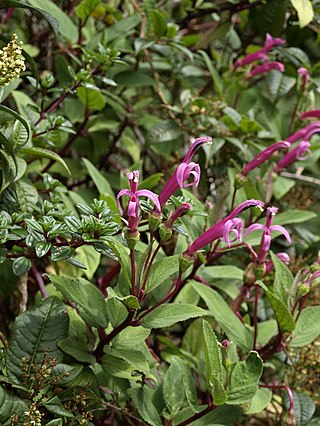
The pineapple is a tropical plant with an edible fruit; it is the most economically significant plant in the family Bromeliaceae.

Ananas is a plant genus in the family Bromeliaceae. It is native to South America. The genus contains Ananas comosus, the pineapple.
Costus barbatus is a critically endangered species of plant native to Costa Rica.

Melianthus is a genus of flowering plants native to elevated grassland in South Africa. A common name for these plants is honey flower, which is also the English translation of the Latin name. This name also attaches to the species M. comosus and M. major that are found in cultivation.
Phyaces is a monotypic genus of Sri Lankan jumping spiders containing the single species, Phyaces comosus. It was first described by Eugène Louis Simon in 1902, and is only found in Sri Lanka.

Eucomis comosa, the pineapple flower, pineapple lily or wine eucomis, is a species of flowering plant in the asparagus family Asparagaceae. A deciduous bulbous perennial used as an ornamental plant, it is endemic to South Africa. The white to purple flowers appear in summer and are arranged in a spike (raceme), topped by a "head" of green leaflike bracts.

Centropogon is a plant genus in the family Campanulaceae. In systems where the Lobeliaceae are recognized as distinct, Centropogon is placed there.

Centropogon comosus is a species of plant in the family Campanulaceae. It is endemic to Ecuador. Its natural habitat is subtropical or tropical moist montane forests.

Melianthus comosus, the honey flower, is a species of flowering plant in the family Francoaceae. It is native to the mostly dry regions of southern Africa. The attractive multi-stemmed shrubs are popular garden subjects. The Afrikaans name kruidjie-roer-my-nie (herb-touch-me-not) alludes to the unpleasant smell that results from bruising of any part of the plant. The vegetative parts are very toxic, as with other Melianthus species, and extracts of the leaves and stem have anti-bacterial properties.

Prosoplus is a genus of longhorn beetles of the subfamily Lamiinae, containing the following species:
Prosoplus atlanticus is a species of beetle in the family Cerambycidae. It was described by Stephan von Breuning in 1938.
Prosoplus imitans is a species of beetle in the family Cerambycidae. It was described by Stephan von Breuning in 1961.

Rhytiphora bankii is a species of beetle in the family Cerambycidae. It was first described by Johan Christian Fabricius in 1775, under the genus Lamia. It is known from Australia, the Philippines, Borneo, Java, Micronesia, New Guinea, Hawaii, Moluccas, Sumatra, Vietnam, and has been introduced into Japan. The Australian species of Prosoplus were synonymised with Rhytiphora in 2013.
Prosoplus costatus is a species of beetle in the family Cerambycidae. It was described by Karl-Ernst Hüdepohl in 1996. It is known from Borneo and Malaysia.
Prosoplus dentatus is a species of beetle in the family Cerambycidae. It was described by Guillaume-Antoine Olivier in 1792. It is known from Mauritius, Seychelles, Réunion, and Madagascar. It contains the varietas Prosoplus dentatus var. ochreomaculatus.
Prosoplus lividus is a species of beetle in the family Cerambycidae. It was described by Masaki Matsushita in 1935.
Prosoplus sinuatofasciatus is a species of beetle in the family Cerambycidae. It was described by Blanchard in 1855.
Neomochtherus comosus is a species of robber flies in the family Asilidae.

Coleus comosus, synonym Plectranthus ornatus, is a flowering plant from the mint family Lamiaceae, native to eastern Africa.

Costus comosus, known as red tower ginger, is a species of plant native to South Mexico to Ecuador.










